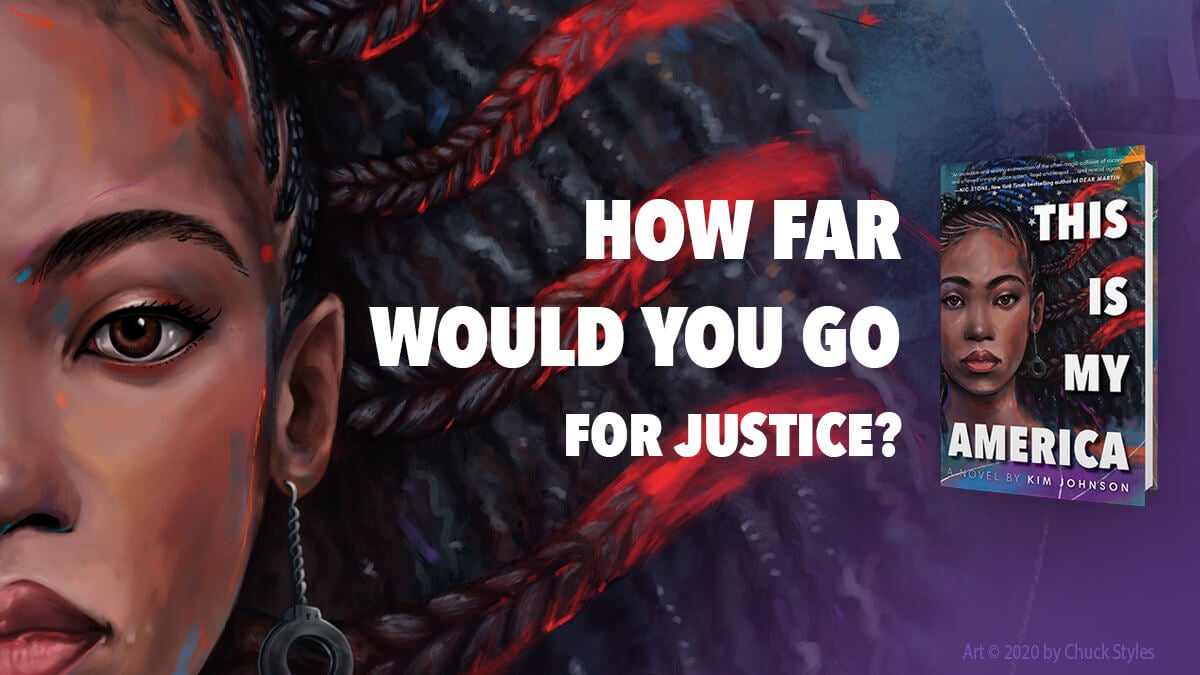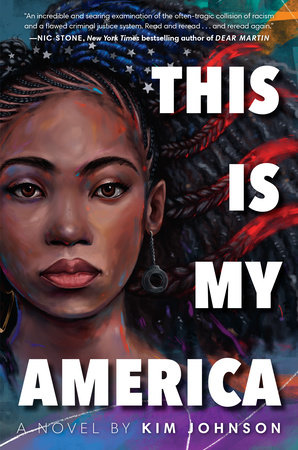One of our favorite Book Nerd activities is going to book club! Book clubs create community, help us get through our TBR pile, discover new faves, and allow space to talk about our favorite characters. To help with your book club endeavors, we’ve created book club guides for some of our favorite YA titles. This This Is My America book club guide will help you get the most out of reading Kim Johnson’s searing and inspiring novel about the justice system. Dive into these insightful discussion questions and start the dialogue.

This Is My America Book Club Guide Discussion Questions
Before Reading
- What does the title mean to you? Complete the sentence with as many associations as possible: My America is . . .
- Research the term prison-industrial complex and mass incarceration. Who benefits from this system? Who suffers under it? Use the links below as a starting point.
- criticalresistance.org/about/not-so-common-language/
- prisonpolicy.org/reports/money.html
- prisonpolicy.org/reports/pie2020.html
- sentencingproject.org
- themarshallproject.org/records/617-mass-incarceration
- Review the Bill of Rights. Which protected freedom is most important to you? Why?
While You Read
- The book begins, “Time runs my life” (p. 3). How do details, writing style, and structure contribute to the reader’s sense of time? How does time “run” Tracy’s life and the lives of other characters?
- When the sheriff refers to Jamal as “boy,” Tracy reflects, “The word boy keeps running in my head. A bitter taste flushes in my mouth, the way that word drawls out like just another slur in coded language” (p. 70). What are the connotations of the word “boy”? What does Tracy mean when she says there is a “coded language”?
- Compare the experiences of Jackson Ridges, Daddy Greg, and Tracy’s father. How do their experiences living under the prison-industrial complex affect them and their families?
- After Angela’s murder, the school brings in grief counselors (p. 109). Compare public and private mourning in this book. Who is most likely to be publicly mourned, and why? 8
- Reflect on the chapter title “Guilty . . . Until Proven Innocent.” Discuss if the presumption of innocent until proven guilty applies equally across race and class. In what ways do Black men experience interactions with the police that might differ by race and gender?
- Tracy thinks, “I wish I could trust [the police] automatically, but I can’t. History has a way of latching on to you. Like touching a hot stove—you only need to do it once before you know better” (p. 269). Consider what it means to touch a hot stove. Who or what is responsible for Tracy’s trauma? How do other characters in the book cope with their own trauma?
- Reflect on mystery books you have read or crime shows you have watched. What motivates characters to solve the mystery? Discuss Tracy’s process for gathering evidence. Why is it risky? Why is it necessary?
- The author chose not to have Jamal text his version of events to Tracy. Why does Johnson choose to omit Jamal’s story for most of the narrative?
- Why does Richard Brighton yell “gun!”? (p. 360) Who had the benefit of the doubt in this scene? In what ways might the response have been different if Jamal and Angela switched roles in the story?
- Tracy says about Jamal, “He’s everything on the outside I wish to be” (p. 3). By the end of the book, does Tracy still believe this?
After Reading
- How do the characters differ in the ways they “work for justice.” Discuss the paths each character takes:
- The sheriff
- Tracy
- Beverly
- Mrs. Evans
- Steven
- Consider the role of media in the book. How is it helpful or harmful? Whose interests does the media serve? What are examples of media responding differently when race, gender, or class are at play?
- Tracy quotes Dr. King in one of her letters to Innocence X. “The arc of the moral universe is long, but it bends towards justice.” Do you agree with Dr. King’s vision? Is Johnson’s ending hopeful?
- Tracy protects and informs her community by organizing Know Your Rights workshops. Do research to learn what your rights are (aclu.org/know-your-rights). Attend a training or organize one for your school or community.
- What is Johnson’s commentary on racism?
Check out This Is My America
About the Author
This Is My America is Kim Johnson’s debut novel. Kim Johnson held leadership positions in social justice organizations as a teen. She’s now a college administrator who mentors Black student activists and leaders. She holds degrees from the University of Oregon and the University of Maryland, College Park. Kim lives her best life in Oregon with her husband and two kids. Find her at KCJohnsonWrites.com and follow her on Twitter and Instagram @kcjohnsonwrites.


